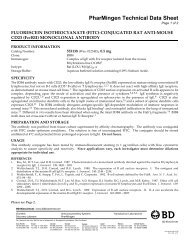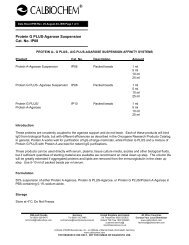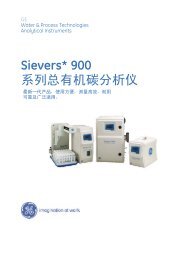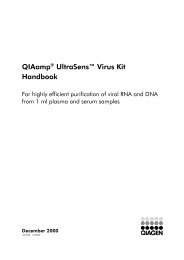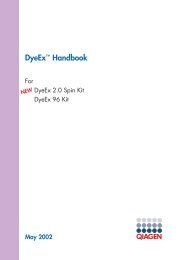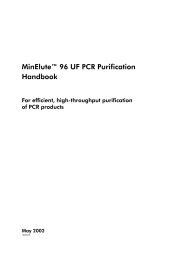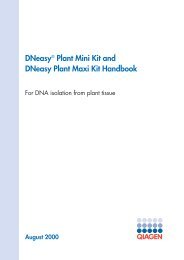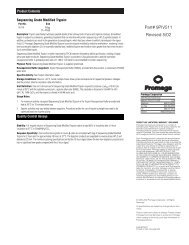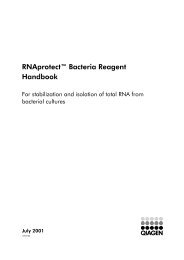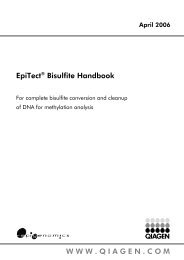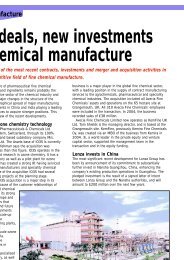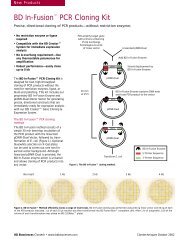Rabbit Reticulocyte Lysate System Technical Manual, TM232
Rabbit Reticulocyte Lysate System Technical Manual, TM232
Rabbit Reticulocyte Lysate System Technical Manual, TM232
You also want an ePaper? Increase the reach of your titles
YUMPU automatically turns print PDFs into web optimized ePapers that Google loves.
<strong>Rabbit</strong> <strong>Reticulocyte</strong> <strong>Lysate</strong><br />
<strong>System</strong><br />
<strong>Technical</strong> <strong>Manual</strong> No. 232<br />
INSTRUCTIONS FOR USE OF PRODUCTS L4960 AND L4151. PLEASE DISCARD PREVIOUS VERSIONS.<br />
All technical literature is available on the Internet at www.promega.com<br />
Please visit the web site to verify that you are using the most current version of this <strong>Technical</strong> <strong>Manual</strong>.<br />
I. Description ............................................................................................................2<br />
A. <strong>Rabbit</strong> <strong>Reticulocyte</strong> <strong>Lysate</strong>, Nuclease Treated ................................................2<br />
B. <strong>Rabbit</strong> <strong>Reticulocyte</strong> <strong>Lysate</strong>, Untreated ............................................................2<br />
C. Applications .....................................................................................................3<br />
II. Product Components ...........................................................................................3<br />
III. General Considerations .......................................................................................3<br />
IV. <strong>Rabbit</strong> <strong>Reticulocyte</strong> <strong>Lysate</strong> <strong>System</strong> ....................................................................4<br />
A. Translation Procedure......................................................................................4<br />
V. Cotranslational Processing Using Canine Pancreatic<br />
Microsomal Membranes.......................................................................................8<br />
A. General Protocol for Translation with Canine Pancreatic<br />
Microsomal Membranes ..................................................................................8<br />
VI. Post-Translational Analysis .................................................................................9<br />
A. Determination of Percent Incorporation of Radioactive Label .........................9<br />
B. Denaturing Gel Analysis of Translation Products...........................................10<br />
VII. Positive Control Translation Reactions Using Luciferase...............................11<br />
A. Non-Radioactive Luciferase Control Reaction...............................................11<br />
B. Radioactive Luciferase Control Reaction.......................................................12<br />
VIII. Positive Control Luciferase Assays..................................................................12<br />
A. Standard Luciferase Assay (Luminometer or Scintillation Counter) ..............12<br />
B. Qualitative Visual Detection of Luciferase Activity .........................................13<br />
IX. Related Procedures ............................................................................................14<br />
A. Synthesis of Milligram Quantities of in vitro Transcripts.................................14<br />
B. In vitro Synthesis of Capped RNA Transcript.................................................14<br />
X. Troubleshooting..................................................................................................15<br />
XI. Appendix .............................................................................................................18<br />
A. Composition of Buffers and Solutions ...........................................................18<br />
B. Related Products ...........................................................................................19<br />
C. References ....................................................................................................22<br />
Experienced User’s Protocol........................................................................................24<br />
Promega Corporation · 2800 Woods Hollow Road · Madison, WI 53711-5399 USA · Toll Free in USA 800-356-9526 · Telephone 608-274-4330 · Fax 608-277-2516 · www.promega.com<br />
Printed in USA. Part# <strong>TM232</strong><br />
Revised 3/00 Page 1
I. Description<br />
A. <strong>Rabbit</strong> <strong>Reticulocyte</strong> <strong>Lysate</strong>, Nuclease Treated<br />
<strong>Rabbit</strong> <strong>Reticulocyte</strong> <strong>Lysate</strong> Translation <strong>System</strong>s are utilized in the identification of<br />
mRNA species, the characterization of their protein products and the investigation<br />
of transcriptional and translational control. <strong>Rabbit</strong> <strong>Reticulocyte</strong> <strong>Lysate</strong> is prepared<br />
from New Zealand white rabbits using a standard protocol (1) that ensures reliable<br />
and consistent reticulocyte production in each lot. The reticulocytes are purified to<br />
remove contaminating cells, which could otherwise alter the translational properties<br />
of the final extract. After the reticulocytes are lysed, the extract is treated with<br />
micrococcal nuclease to destroy endogenous mRNA and thus reduce background<br />
translation to a minimum (2). The lysate contains the cellular components necessary<br />
for protein synthesis (tRNA, ribosomes, amino acids, initiation, elongation<br />
and termination factors). <strong>Rabbit</strong> <strong>Reticulocyte</strong> <strong>Lysate</strong> is optimized further for mRNA<br />
translation by the addition of the following:<br />
• an energy-generating system consisting of prequalified phosphocreatine<br />
and phosphocreatine kinase<br />
• a mixture of tRNAs to expand the range of mRNAs that can be translated<br />
• hemin, to prevent inhibition of initiation<br />
• potassium acetate and magnesium acetate<br />
<strong>Rabbit</strong> <strong>Reticulocyte</strong> <strong>Lysate</strong> may contain a variety of post-translational processing<br />
activities, including acetylation, isoprenylation and some phosphorylation activity<br />
(3). Processing events such as signal peptide cleavage and core glycosylation can<br />
be examined by adding Canine Pancreatic Microsomal Membranes (Cat.# Y4041)<br />
to a standard translation reaction (4).<br />
B. <strong>Rabbit</strong> <strong>Reticulocyte</strong> <strong>Lysate</strong>, Untreated<br />
Untreated <strong>Rabbit</strong> <strong>Reticulocyte</strong> <strong>Lysate</strong> contains the cellular components necessary<br />
for protein synthesis (tRNA, ribosomes, amino acids, initiation, elongation and termination<br />
factors) but has not been treated with micrococcal nuclease. Untreated<br />
<strong>Lysate</strong> is used primarily for the isolation of these components and as an abundant<br />
source of endogenous globin mRNA. Untreated <strong>Lysate</strong> is prepared from New<br />
Zealand white rabbits in the same manner as treated lysates with the exception<br />
that it is not treated with micrococcal nuclease (1). The reticulocytes are purified to<br />
remove contaminating cells. The packed cells then are lysed by the addition of<br />
water. Untreated <strong>Rabbit</strong> <strong>Reticulocyte</strong> <strong>Lysate</strong> is provided in 1ml aliquots.<br />
Untreated <strong>Reticulocyte</strong> <strong>Lysate</strong> supplemented with hemin (20µM final concentration)<br />
synthesizes protein from added mRNA templates at approximately the same rate<br />
as treated reticulocyte lysate for up to 60 minutes. The primary disadvantage of<br />
such a system for in vitro translation is that the template mRNA is translated in<br />
competition with endogenous globin mRNA, making quantitation of the activity of<br />
the exogenous mRNA very difficult.<br />
The lysate may be treated with micrococcal nuclease to destroy endogenous<br />
mRNA (2). In the presence of calcium as a cofactor, nuclease treatment is very<br />
effective in eliminating globin mRNA using incubation times as short as 20 minutes.<br />
EGTA is then added to chelate the calcium and thereby inactivate the<br />
nuclease. <strong>Rabbit</strong> <strong>Reticulocyte</strong> <strong>Lysate</strong> may be optimized further by addition of<br />
the components listed in Table 2, Section IV.A. Standard stock solutions and their<br />
preparation are given in Section XI.A. Please see Section IV.A for a standard<br />
translation protocol.<br />
Promega Corporation · 2800 Woods Hollow Road · Madison, WI 53711-5399 USA · Toll Free in USA 800-356-9526 · Telephone 608-274-4330 · Fax 608-277-2516 · www.promega.com<br />
Part# <strong>TM232</strong> Printed in USA.<br />
Page 2<br />
Revised 3/00
C. Applications<br />
Potential applications of the <strong>Rabbit</strong> <strong>Reticulocyte</strong> <strong>Lysate</strong> <strong>System</strong> include:<br />
• Drug screening (affecting<br />
translation rates)<br />
• Mutation and detection analysis<br />
(i.e., enzyme kinetics)<br />
• Protein-protein interactions<br />
(e.g., using GST fusion<br />
proteins)<br />
• Immunoprecipitation of<br />
protein complexes<br />
• Ligand-binding region<br />
determination/confirmation/<br />
competition assays<br />
For additional applications, see reference 5.<br />
II. Product Components<br />
• Protein structure analysis<br />
• Electrophoretic mobility shift<br />
assays (EMSAs) for DNA-protein<br />
interactions<br />
• DNA footprinting and protein<br />
cross-linking studies<br />
• Protein-RNA binding assays<br />
• Post-translational modification<br />
tests<br />
• Verification/characterization of<br />
cloned gene products<br />
• Protein dimerization assays<br />
Product Size Cat.#<br />
<strong>Rabbit</strong> <strong>Reticulocyte</strong> <strong>Lysate</strong> <strong>System</strong>, Nuclease Treated(a,b,c) 1ml L4960<br />
<strong>Rabbit</strong> <strong>Reticulocyte</strong> <strong>Lysate</strong> is provided in 200µl aliquots. Each system contains sufficient<br />
reagents to perform approximately 30 translation reactions per milliliter of lysate. Includes:<br />
• 1ml <strong>Rabbit</strong> <strong>Reticulocyte</strong> <strong>Lysate</strong>, Treated (5 × 200µl)<br />
• 50µl Amino Acid Mixture, Minus Methionine, 1mM<br />
• 50µl Amino Acid Mixture, Minus Leucine, 1mM<br />
• 50µl Amino Acid Mixture, Minus Cysteine, 1mM<br />
• 10µl Luciferase Control RNA(a,b)<br />
• 1 Protocol<br />
Product Size Cat.#<br />
<strong>Rabbit</strong> <strong>Reticulocyte</strong> <strong>Lysate</strong> <strong>System</strong>, Untreated 1ml L4151<br />
Bulk <strong>Rabbit</strong> <strong>Reticulocyte</strong> <strong>Lysate</strong> is available from Promega.<br />
Storage Conditions: Store all components at –70°C. Note that the systems are<br />
shipped in foil packaging due to sensitivity of the system to carbon dioxide (CO2)<br />
released from the dry ice. If storing the system in a freezer containing dry ice, keep<br />
system components sealed in foil packaging for best results. DO NOT store lysate in<br />
the presence of dry ice. Prolonged exposure to dry ice can cause significant loss of<br />
lysate activity. Avoid multiple freeze-thaw cycles or exposure to frequent temperature<br />
changes, as these fluctuations can greatly alter product stability. Do not freeze-thaw<br />
the lysate more than 2 times.<br />
III. General Considerations<br />
In vitro translation systems are used to characterize plasmid clones, study mutations,<br />
examine translational signals and characterize mRNA populations rapidly. Two basic<br />
types of system are available: 1) translation systems for RNA templates, and 2) coupled<br />
transcription/translation systems for DNA templates. Many factors go into the<br />
choice of an in vitro translation system; some of these considerations are summarized<br />
in Section XI.B, Related Products.<br />
DO NOT<br />
...store lysate in presence<br />
of dry ice. In addition, do<br />
not freeze-thaw the lysate<br />
more than 2 times.<br />
Promega Corporation · 2800 Woods Hollow Road · Madison, WI 53711-5399 USA · Toll Free in USA 800-356-9526 · Telephone 608-274-4330 · Fax 608-277-2516 · www.promega.com<br />
Printed in USA. Part# <strong>TM232</strong><br />
Revised 3/00 Page 3
Note: An Experienced<br />
User’s Protocol can be<br />
found at the end of this<br />
<strong>Technical</strong> <strong>Manual</strong>.<br />
The reaction conditions provided below are optimized for the Luciferase Control RNA<br />
supplied with the system and should be considered as a starting point for experiments.<br />
Many factors affect translation efficiency of specific mRNAs in the <strong>Rabbit</strong> <strong>Reticulocyte</strong><br />
<strong>Lysate</strong> <strong>System</strong> and should be considered when designing in vitro translation experiments.<br />
The optimal mRNA concentration will vary for particular transcripts and should<br />
be determined empirically. In addition, the presence of certain nucleic acid sequence<br />
elements can have profound effects on initiation fidelity and translation efficiency.<br />
Poly(A)+ tails, 5´-caps, 5´-untranslated regions and the sequence context around<br />
the AUG start (or secondary AUGs in the sequence) (6) all may affect translation of<br />
a given mRNA.<br />
For more information on these variables, please read the notes in Section IV.A and<br />
articles in Promega Notes (7). Allow approximately 1.5 hours to perform the translation<br />
reaction (Figure 1).<br />
Figure 1. Flow chart of in vitro translation procedure using <strong>Rabbit</strong> <strong>Reticulocyte</strong> <strong>Lysate</strong>.<br />
IV. <strong>Rabbit</strong> <strong>Reticulocyte</strong> <strong>Lysate</strong> <strong>System</strong><br />
A. Translation Procedure<br />
Standard in vitro Translation<br />
Isolate RNA<br />
(generated<br />
in vitro or from tissue).<br />
Perform in vitro translation<br />
using <strong>Rabbit</strong> <strong>Reticulocyte</strong><br />
<strong>Lysate</strong>.<br />
Separate translation<br />
products by SDS-PAGE.<br />
Fix and dry gel.<br />
(Fluorography optional)<br />
Autoradiography.<br />
Time required = 8 hours<br />
(1.5 hours, 30°C)<br />
(1.5 hours)<br />
(2 hours)<br />
(3 hours, −70°C)<br />
The following is a general guideline for setting up a translation reaction. Examples<br />
are provided for standard reactions using [35S]methionine (radioactive) or<br />
Transcend Non-Radioactive Detection <strong>System</strong>s. Using the Transcend<br />
<strong>System</strong>s, biotinylated lysine residues are incorporated into nascent proteins during<br />
translation, eliminating the need for labeling with [ 35S]methionine or other<br />
radioactive amino acids. This biotinylated lysine is added to the translation<br />
reaction as a precharged ε-labeled biotinylated lysine-tRNA complex<br />
(Transcend tRNA) rather than a free amino acid. For more information on the<br />
Promega Corporation · 2800 Woods Hollow Road · Madison, WI 53711-5399 USA · Toll Free in USA 800-356-9526 · Telephone 608-274-4330 · Fax 608-277-2516 · www.promega.com<br />
Part# <strong>TM232</strong> Printed in USA.<br />
Page 4<br />
Revised 3/00<br />
0450TA01/2A
Transcend <strong>System</strong>s, refer to the Transcend Non-Radioactive Translation<br />
Detection <strong>System</strong>s <strong>Technical</strong> Bulletin #TB182. This document may be requested<br />
from Promega Corporation or is available on the Internet at www.promega.com.<br />
Several measures should be taken to reduce the chance of RNase contamination.<br />
Gloves should be worn throughout the experiment. Use microcentrifuge tubes<br />
and pipette tips that have been exposed only to gloved handling. The addition of<br />
RNasin® Ribonuclease Inhibitor (a) to the translation reaction is recommended but<br />
not required. RNasin® Ribonuclease Inhibitor prevents degradation of sample<br />
mRNAs by contaminating RNases.<br />
Materials to Be Supplied by the User<br />
• RNasin® Ribonuclease Inhibitor (Cat.# N2111, N2115 or N2511)<br />
• Nuclease-Free Water (Cat.# P1193)<br />
• appropriately labeled amino acid<br />
• Transcend Colorimetric (Cat.# L5070) or Chemiluminescent (Cat.# L5080)<br />
Translation Detection <strong>System</strong> (for non-radioactive detection)<br />
• Transcend tRNA (Cat.# L5061; for non-radioactive detection)<br />
1. Remove the reagents from storage and allow them to thaw slowly on ice.<br />
2. Denature the template mRNA at 65°C for 3 minutes and immediately cool in<br />
an ice-water bath. This increases the efficiency of translation, especially of<br />
GC-rich mRNA, by destroying local regions of secondary structure.<br />
3. Assemble the reaction components, appropriate to the label being used, in a<br />
0.5ml polypropylene microcentrifuge tube. Gently mix the lysate by stirring<br />
with a pipette tip upon addition of each component. If necessary, centrifuge<br />
briefly to return the sample to the bottom of the tube. We recommend<br />
including a control reaction containing no mRNA. This allows<br />
measurement of any background incorporation of labeled amino acids.<br />
Examples of Standard Reactions<br />
Standard<br />
Standard<br />
Reaction Using<br />
Reaction Using Transcend<br />
Component [35S]methionine tRNA<br />
<strong>Rabbit</strong> <strong>Reticulocyte</strong> <strong>Lysate</strong> 35µl 35µl<br />
Amino Acid Mixture, Minus Leucine, 1mM – 0.5µl<br />
Amino Acid Mixture, Minus Methionine, 1mM<br />
[35S]methionine (1,200Ci/mmol at 10mCi/ml)<br />
1µl 0.5µl<br />
(see Notes 2 and 3) 2µl –<br />
RNasin® Ribonuclease Inhibitor (40u/µl)<br />
RNA substrate in water (1µg/µl)<br />
1µl 1µl<br />
(see Notes 4 and 5) 2µl 2µl<br />
Transcend Biotin-Lysyl-tRNA (see Note 8) 1µl<br />
Nuclease-Free Water to a final volume of 50µl 50µl<br />
Note: A lysate volume of 35µl (70% concentration) is optimal for translation of many<br />
RNAs. However, with certain RNAs, translation efficiency may increase by varying<br />
the lysate volume from 25µl (50% concentration) to 35µl (70% concentration). To<br />
achieve maximal expression in a reaction containing diluted lysate, it may be<br />
necessary to optimize the Mg 2+ and K + concentrations.<br />
4. Immediately incubate the translation reactions at 30°C for 90 minutes.<br />
Note: For control reactions<br />
using Luciferase<br />
RNA, please see<br />
Section VII.<br />
Note: Smaller scale<br />
translation reactions<br />
may be performed by<br />
reducing the recommended<br />
volumes<br />
proportionally.<br />
Promega Corporation · 2800 Woods Hollow Road · Madison, WI 53711-5399 USA · Toll Free in USA 800-356-9526 · Telephone 608-274-4330 · Fax 608-277-2516 · www.promega.com<br />
Printed in USA. Part# <strong>TM232</strong><br />
Revised 3/00 Page 5
5. Analyze the results of translation. Procedures are provided for incorporation<br />
assays (Section VI.A), gel analysis of translation products (Section VI.B) and<br />
an assay for luciferase production in the control reactions (Section VIII). For<br />
analysis of reactions using Transcend tRNA, refer to Promega’s<br />
Transcend Non-Radioactive Detection <strong>System</strong>s <strong>Technical</strong> Bulletin #TB182.<br />
Notes:<br />
1. The addition of RNasin® Ribonuclease Inhibitor to the translation reaction is<br />
recommended but not required. RNasin® Ribonuclease Inhibitor acts to<br />
inhibit contaminating RNases.<br />
2. We have found acceptable results using 1–4µl of [35S]methionine (1,200Ci/mmol)<br />
at 10mCi/ml. Depending upon the translational efficiency of the experimental<br />
RNA and number of methionine residues present in the protein, the amount of<br />
[ 35S]methionine can be adjusted to balance exposure time versus cost of label.<br />
Other radiolabeled amino acids can be used with the <strong>Rabbit</strong> <strong>Reticulocyte</strong><br />
<strong>Lysate</strong> <strong>System</strong>. See Table 1 for recommendations.<br />
Table 1. Recommended Volumes of Alternative Radiolabeled Amino<br />
Acids.<br />
Amino Acid Volume to Add to Reaction<br />
[3H]leucine (100–200Ci/mmol) 5ml<br />
[ 14C]leucine (300mCi/mmol) 5ml<br />
[ 35S]cysteine (1,200Ci/mmol) 5ml<br />
3. Redivue L-[35S]methionine (Amersham Pharmacia Biotech Ltd.,<br />
Cat.# AG1094) is recommended. This grade of [ 35S]methionine does not<br />
cause the background labeling of the rabbit reticulocyte lysate 42kDa protein<br />
that can occur using other grades of label (8). In addition, a stabilizer<br />
has been added to increase the stability above that of conventional radiolabeled<br />
amino acids, so that the release of volatile gases is reduced substantially.<br />
This [35S]methionine may be stored at 4°C without aliquoting. Other<br />
types of 35S-labeled amino acids may be oxidized easily to translationinhibiting<br />
sulfoxides and should be stored in aliquots in buffer containing<br />
DTT or β-mercaptoethanol at –70°C.<br />
4. An unfractionated total cytoplasmic RNA preparation is 90–95% rRNA, and<br />
as a result the mRNA translates poorly. Usually such preparations yield no<br />
better than 20–30% of the maximum incorporation attainable, and high final<br />
concentrations of 100–200µg/ml of RNA are needed to stimulate translation.<br />
In contrast, viral RNAs and poly(A)+ mRNAs (including mRNA transcribed in<br />
vitro) can be used at much lower concentrations. Using in vitro transcripts<br />
produced with Promega’s RiboMAX Large Scale RNA Production<br />
<strong>System</strong>s (a,b,d,e) (see Section IX.A), a final concentration of 5–80µg/ml in<br />
vitro transcript may be used for the translation. Using the RiboMAX<br />
<strong>System</strong>s, milligram quantities of RNA can be produced. RNA from other<br />
standard transcription procedures may contain components at concentrations<br />
that inhibit translation. Therefore, a lower concentration of 5–20µg/ml<br />
in vitro transcript should be used.<br />
For preparation of DNA that will be used as a template for run-off RNA<br />
transcript production, Promega’s Wizard® SV DNA Purification <strong>System</strong>s (f) or<br />
Wizard® PCR Preps DNA Purification <strong>System</strong>(g) are recommended.<br />
Promega’s SV Total RNA Isolation <strong>System</strong> (h) is ideal for purifying total RNA,<br />
Promega Corporation · 2800 Woods Hollow Road · Madison, WI 53711-5399 USA · Toll Free in USA 800-356-9526 · Telephone 608-274-4330 · Fax 608-277-2516 · www.promega.com<br />
Part# <strong>TM232</strong> Printed in USA.<br />
Page 6<br />
Revised 3/00
free from DNA contamination. Promega’s PolyATtract ® mRNA Isolation<br />
<strong>System</strong>s, utilizing MagneSphere® technology, may be used for purifying<br />
run-off RNAs or isolating poly(A)+ mRNA free from other nucleic acid<br />
contamination in approximately 45 minutes.<br />
5. Average preparations of mRNA give a stimulation over background of about<br />
10- to 20-fold. If the translation efficiency of sample mRNA is low, refer to<br />
Section X, Troubleshooting.<br />
6. Hemin is added to <strong>Rabbit</strong> <strong>Reticulocyte</strong> <strong>Lysate</strong> because it suppresses an<br />
inhibitor of the initiation factor elF2α. In the absence of hemin, protein<br />
synthesis in the <strong>Reticulocyte</strong> <strong>Lysate</strong> <strong>System</strong> will cease after a short period<br />
of incubation (8).<br />
7. The addition of polyamines, such as spermidine (0.1–0.5mM) and certain<br />
diamines (0.1–40mM), has been shown to stimulate translation (9). The<br />
addition of these compounds results in reduction of the corresponding<br />
optimal Mg2+ concentration for a given RNA. Therefore, less Mg2+ is<br />
required for the translation reaction.<br />
8. The level of added Transcend tRNA can be increased (1–4µl) to allow more<br />
sensitive detection of proteins that contain few lysines or are poorly expressed.<br />
9. Except for actual translation incubation, all <strong>Rabbit</strong> <strong>Reticulocyte</strong> <strong>Lysate</strong><br />
<strong>System</strong> components should be kept on ice while in use. Unused <strong>Rabbit</strong><br />
<strong>Reticulocyte</strong> <strong>Lysate</strong> should be frozen on a dry ice/ethanol bath and stored at<br />
–70°C. Do not freeze-thaw the lysate more than two times.<br />
10. Each batch of <strong>Rabbit</strong> <strong>Reticulocyte</strong> <strong>Lysate</strong> contains 100–200mg/ml of<br />
endogenous protein (using BSA as a standard).<br />
11. Use capped plastic vials or covered microwell plates. This avoids changes in the<br />
reaction volume that may affect the concentration of important components.<br />
12. RNase A can be added to the completed translation reaction to digest<br />
aminoacyl tRNAs, which sometimes produce background bands through<br />
interactions with endogenous lysate proteins. Add RNase A to a final<br />
concentration of 0.2mg/ml for 5 minutes at room temperature.<br />
Table 2. Final Concentrations of <strong>Rabbit</strong> <strong>Reticulocyte</strong> <strong>Lysate</strong><br />
Components Added to a 50µl Translation Reaction.<br />
Component Concentration<br />
Creatine phosphate 10mM<br />
Creatine phosphokinase 50µg/ml<br />
DTT 2mM<br />
Calf liver tRNA 50µg/ml<br />
Potassium acetate 79mM<br />
Magnesium acetate 0.5mM<br />
Hemin 0.02mM<br />
DO NOT<br />
...freeze-thaw the lysate<br />
more than 2 times.<br />
Promega Corporation · 2800 Woods Hollow Road · Madison, WI 53711-5399 USA · Toll Free in USA 800-356-9526 · Telephone 608-274-4330 · Fax 608-277-2516 · www.promega.com<br />
Printed in USA. Part# <strong>TM232</strong><br />
Revised 3/00 Page 7
Note: RNasin ®<br />
Ribonuclease Inhibitor<br />
(approximately 40 units)<br />
may be added to the<br />
reaction.<br />
Table 3. Approximate Endogenous Amino Acid Pools (mM).<br />
Amino Concentration Amino Concentration<br />
Acid (in µM) Acid (in µM)<br />
Ala 157 Leu 5<br />
Asn 51 Lys 51<br />
Asp 1,093 Met 5<br />
Arg 41 Phe 4<br />
Cys 2 Pro 87<br />
Gln 200 Ser 93<br />
Glu 260 Thr 59<br />
Gly 1,050 Trp 1<br />
His 14 Tyr 3<br />
Ile 9 Val 30<br />
These amino acid concentrations should be used only as estimates. These values are<br />
not determined for individual lots of <strong>Rabbit</strong> <strong>Reticulocyte</strong> <strong>Lysate</strong>.<br />
V. Cotranslational Processing Using Canine Pancreatic Microsomal Membranes<br />
A. General Protocol for Translation with Canine Pancreatic Microsomal<br />
Membranes<br />
The following protocol should be used with Promega’s <strong>Rabbit</strong> <strong>Reticulocyte</strong><br />
<strong>Lysate</strong> <strong>System</strong>, Nuclease Treated (Cat.# L4960). For more information on using<br />
Canine Pancreatic Microsomal Membranes(a), see the Canine Microsomal<br />
Membranes <strong>Technical</strong> <strong>Manual</strong> #TM231.<br />
Materials to Be Supplied by the User<br />
• Nuclease-Free Water (Cat.# P1193)<br />
• Optional: RNasin ® Ribonuclease Inhibitor (Cat.# N2111, N2115 or N2511)<br />
• isotopically labeled amino acids, typically [35S]methionine, [ 35S]cysteine,<br />
[3H]leucine or [14C]leucine<br />
1. Remove the reagents from the freezer and allow them to thaw on ice.<br />
2. Mix the following components on ice, in the order given, in a sterile<br />
microcentrifuge tube:<br />
Nuclease-Treated <strong>Rabbit</strong> <strong>Reticulocyte</strong> <strong>Lysate</strong> 17.5µl<br />
Amino Acid Mixture, Minus Methionine, 1mM 0.5µl<br />
[ 35S]methionine (1,200Ci/mmol) at 10mCi/ml 2.0µl<br />
Canine Microsomal Membranes (see Note 1 below)<br />
RNA substrate in water (pre β-lactamase and α-factor<br />
1–3µl<br />
mRNA at 0.1µg/µl) 1.0µl<br />
Nuclease-Free Water to a final volume of 25µl<br />
3. Incubate at 30°C for 60 minutes.<br />
4. Analyze the results of translation and processing. Procedures are provided<br />
for gel analysis of translation products (Section VI.B).<br />
Notes:<br />
1. The amount of Canine Microsomal Membranes that are used in the reaction<br />
may need to be titrated. While these reaction conditions will be suitable for<br />
most applications, the efficiency of processing using membranes may vary.<br />
Promega Corporation · 2800 Woods Hollow Road · Madison, WI 53711-5399 USA · Toll Free in USA 800-356-9526 · Telephone 608-274-4330 · Fax 608-277-2516 · www.promega.com<br />
Part# <strong>TM232</strong> Printed in USA.<br />
Page 8<br />
Revised 3/00
Thus, reaction parameters may need to be altered to suit individual<br />
requirements. In general, increasing the amount of membranes in the<br />
reaction increases the proportion of polypeptides that are processed but<br />
reduces the total amount of polypeptide synthesized.<br />
2. When analyzed by SDS gel electrophoresis, the precursor for β-lactamase<br />
migrates at 31.5kDa, and the processed β-lactamase migrates at 28.9kDa.<br />
The precursor for the α-factor migrates at 18.6kDa, and the core-glycosylated<br />
α-factor has a molecular weight of 32.0kDa but will migrate faster than the<br />
β-lactamase precursor.<br />
3. Depending on the mRNA under examination, translation efficiency can<br />
be expected to drop between 10–50% in the presence of Canine<br />
Microsomal Membranes.<br />
4. Storage buffer for the Canine Microsomal Membranes consists of 50mM<br />
triethanolamine, 2mM DTT and 250mM sucrose.<br />
5. In some cases, it is difficult to determine by gel analysis alone if efficient<br />
processing or glycosylation has occurred. For alternative procedures for<br />
determining if cotranslational processing has occurred, see the Canine<br />
Microsomal Membranes <strong>Technical</strong> <strong>Manual</strong> #TM231.<br />
VI. Post-Translational Analysis<br />
Materials to Be Supplied by the User<br />
(Solution compositions are provided in Section XI.A)<br />
• 1M NaOH/2% H2O2<br />
• 25% TCA/2% casamino acids<br />
(Difco® brand, Vitamin Assay<br />
Grade)<br />
• 5% TCA<br />
• Whatman ® GF/A glass fiber filter<br />
(Whatman® Cat.# 1820021)<br />
• acetone<br />
• 30% acrylamide solution<br />
• fixing solution<br />
• separating gel 4X buffer<br />
• stacking gel 4X buffer<br />
• SDS polyacrylamide 10X running<br />
buffer<br />
• Optional: precast polyacrylamide<br />
gels<br />
• fixing solution<br />
• Whatman® 3MM filter paper<br />
A. Determination of Percent Incorporation of Radioactive Label<br />
1. After the 50µl translation reaction is complete, remove 2µl from the reaction<br />
and add it to 98µl of 1M NaOH/2% H2O2.<br />
2. Vortex briefly and incubate at 37°C for 10 minutes.<br />
3. At the end of the incubation, add 900µl of ice-cold 25% TCA/2% casamino<br />
acids to precipitate the translation product. Incubate on ice for 30 minutes.<br />
4. Wet a Whatman ® GF/A glass fiber filter with a small amount of cold 5%<br />
TCA. Collect the precipitate by vacuum filtering 250µl of the TCA reaction<br />
mix (Step 3). Rinse the filter three times with 1–3ml of ice-cold 5% TCA.<br />
Rinse once with 1–3ml of acetone. Allow the filter to dry at room temperature<br />
or under a heat lamp for at least 10 minutes.<br />
5. For determination of 35S incorporation, put the filter in 1–3ml of appropriate<br />
scintillation fluid, invert to mix, and count in a liquid scintillation counter.<br />
Promega Corporation · 2800 Woods Hollow Road · Madison, WI 53711-5399 USA · Toll Free in USA 800-356-9526 · Telephone 608-274-4330 · Fax 608-277-2516 · www.promega.com<br />
Printed in USA. Part# <strong>TM232</strong><br />
Revised 3/00 Page 9
6. To determine total counts present in the reaction, spot a 5µl aliquot of the<br />
TCA reaction mix directly onto a filter. Dry the filter for 10 minutes. Count in<br />
a liquid scintillation counter as in Step 5. The measured counts per minute<br />
(cpm) are the cpm in 5µl of the TCA reaction mix.<br />
7. To determine background counts, remove 2µl from a 50µl translation<br />
reaction containing no RNA and proceed as described in Steps 1–5.<br />
8. Perform the following calculation to determine percent incorporation:<br />
cpm of washed filter (Step 4)<br />
× 100 = percent incorporation<br />
cpm of unwashed filter (Step 6) × 50<br />
9. Perform the following calculation to determine the amount of stimulation<br />
above background levels:<br />
cpm of washed filter (Step 4) = fold stimulation<br />
cpm of “no RNA control reaction” washed filter (Step 7)<br />
B. Denaturing Gel Analysis of Translation Products<br />
The most widely applicable and versatile method for analysis of cell-free<br />
translation products synthesized from mixtures of RNAs is polyacrylamide slab<br />
gel electrophoresis in the presence of 0.1% sodium dodecyl sulfate (SDS) and a<br />
discontinuous buffer system. A 10% acrylamide separating gel gives good<br />
separation of peptide mixtures between 20kDa and 100kDa with peptides<br />
between 55kDa and 60kDa migrating halfway down the length of the gel.<br />
Alternatively, precast polyacrylamide gels are available from a number of manufacturers.<br />
For protein analysis, NOVEX and Bio-Rad ® Laboratories, Inc., offer<br />
a variety of precast mini-gels, which are compatible with their vertical electrophoresis<br />
and blotter systems. These companies offer Tris-Glycine, Tricine and<br />
Bis-Tris gels for resolution of proteins under different conditions and over a broad<br />
spectrum of sizes. The NOVEX 4–20% Tris-Glycine gradient gels (NOVEX<br />
Cat.# EC6025 or EC60355) and the Bio-Rad® Ready Gel 4–20% Tris-Glycine Gel,<br />
10-well (Bio-Rad® Cat.# 161-0903) are convenient for resolving proteins over a<br />
wide range of molecular weights. In addition to convenience and safety, precast<br />
gels give consistent results.<br />
1. Once the 50µl translation reaction is complete (or at any desired timepoint),<br />
remove a 5µl aliquot and add it to 20µl of SDS sample buffer. The remainder<br />
of the reaction may be stored at –20°C.<br />
2. Cap the tube and heat at 100°C for 2 minutes to denature the proteins.<br />
Note: In some cases, high molecular weight complexes are formed at<br />
100°C, and denaturation may need to be performed at lower temperatures<br />
(e.g., 20 minutes at 60°C or 3–4 minutes at 80–85°C).<br />
3. Load a small aliquot (5–10µl) onto an SDS-polyacrylamide gel or store at<br />
–20°C. It is not necessary to separate labeled polypeptides from free amino<br />
acids by acetone precipitation.<br />
4. Typically, electrophoresis is carried out at a constant current of 15mA in a<br />
stacking gel and 30mA in a separating gel (or 30mA for a gradient gel).<br />
Electrophoresis is usually performed until the bromophenol blue dye has run<br />
off the bottom of the gel. However, the dye front also contains the free<br />
labeled amino acids, so disposal of unincorporated label may be easier if<br />
the gel is stopped while the dye front remains in the gel. Proceed to Step 7<br />
for Western blotting analysis.<br />
Promega Corporation · 2800 Woods Hollow Road · Madison, WI 53711-5399 USA · Toll Free in USA 800-356-9526 · Telephone 608-274-4330 · Fax 608-277-2516 · www.promega.com<br />
Part# <strong>TM232</strong> Printed in USA.<br />
Page 10<br />
Revised 3/00
5. Place the polyacrylamide gel in a plastic box and cover the gel with fixing<br />
solution (as prepared in Section XI.A). Agitate slowly on an orbital shaker for<br />
30 minutes. Pour off the fixing solution. Proceed to Step 6 (gel drying prior to<br />
film exposure).<br />
Optional: Labeled protein bands in gels may be visualized by autoradiography<br />
or fluorography. Fluorography dramatically increases the sensitivity of detection<br />
of 35S-, 14C- and 3H-labeled proteins. The increased detection sensitivity<br />
of fluorography is obtained by infusing an organic scintillant into the gel. The<br />
scintillant converts the emitted energy of the isotope to visible light and<br />
increases the proportion of energy that may be detected by X-ray film.<br />
Commercial reagents, such as Amplify Reagent (Amersham), can be<br />
used for fluorographic enhancement of signal. Alternatively, the fixed gel can<br />
be exposed to a phosphor screen. These systems provide greater sensitivity,<br />
greater speed and the ability to quantitate the radioactive bands.<br />
6. Dry the gel for exposure to film as follows: Soak the gel in a mixture of 7%<br />
acetic acid, 7% methanol, 1% glycerol for 5 minutes to prevent the gel from<br />
cracking during drying. Place the gel on a sheet of Whatman® 3MM filter<br />
paper, cover with plastic wrap and dry at 80°C for 30–90 minutes under a<br />
vacuum using a conventional gel dryer; dry completely. The gel also may be<br />
dried overnight using Promega’s Gel Drying Kit (Cat.# V7120). To decrease<br />
the likelihood of cracking gradient gels, dry them with the wells pointing<br />
down. It is advantageous to cut or mark one corner of the filter to help in<br />
discerning the gel orientation on the filter. Expose the gel on X-ray film (for<br />
1–6 hours at –70°C (with fluorography), or 6–15 hours at room temperature<br />
(with autoradiography).<br />
7. For Western blot analysis of proteins, transfer (immobilize) the protein from<br />
the gel onto nitrocellulose or PVDF membrane (10,11). Usually Western blots<br />
are made by electrophoretic transfer of proteins from SDS-polyacrylamide<br />
gels. Detailed procedures for electrophoretic blotting usually are included<br />
with commercial devices and can be found in references 10, 12, 13 and 14.<br />
A general discussion of Western blotting with PVDF membranes is found in<br />
reference 15. PVDF membranes must be prewet in methanol or ethanol<br />
before equilibrating in transfer buffer. The blot then may be subjected to<br />
immunodetection analysis. For more information, refer to Promega’s<br />
Protocols and Applications Guide, Third Edition (16).<br />
VII. Positive Control Translation Reactions Using Luciferase<br />
The assay for firefly luciferase activity is extremely sensitive, rapid and easy to<br />
perform. It is a good control for in vitro translations because only full-length luciferase<br />
is active. Additionally, luciferase is a monomeric protein (61kDa) that does not require<br />
post-translational processing or modification for enzymatic activity. The control reaction<br />
can be performed with or without the addition of radiolabeled amino acids.<br />
A. Non-Radioactive Luciferase Control Reaction<br />
Note: To analyze these reactions using a standard luciferase assay, Luciferase<br />
Assay Reagent(c) is required. Both the Amino Acid Mixture, Minus Leucine, and<br />
the Amino Acid Mixture, Minus Methionine, are used in this reaction. By using both<br />
incomplete mixes, a sufficient concentration of all amino acids is obtained. As an<br />
alternative to assaying luciferase activity, this reaction can be performed using<br />
the Transcend tRNA and Non-Radioactive Detection <strong>System</strong>s. For more information<br />
on these systems, request the <strong>Technical</strong> Bulletin #TB182.<br />
Promega Corporation · 2800 Woods Hollow Road · Madison, WI 53711-5399 USA · Toll Free in USA 800-356-9526 · Telephone 608-274-4330 · Fax 608-277-2516 · www.promega.com<br />
Printed in USA. Part# <strong>TM232</strong><br />
Revised 03/00 Page 11
1. Assemble the following reaction:<br />
<strong>Rabbit</strong> <strong>Reticulocyte</strong> <strong>Lysate</strong> (see Section IV.A) 35µl<br />
Amino Acid Mixture, Minus Leucine, 1mM 0.5µl<br />
Amino Acid Mixture, Minus Methionine, 1mM 0.5µl<br />
RNasin® Ribonuclease Inhibitor (40u/µl) 1µl<br />
Luciferase Control RNA (1µg/µl) 1µl<br />
Nuclease-Free Water 12µl<br />
Final volume of 50µl<br />
2. Incubate the translation reaction at 30°C for 90 minutes.<br />
3. Test for the synthesis of functional luciferase using either the standard<br />
luciferase assay (Section VIII.A) or photographic luciferase assay<br />
(Section VIII.B).<br />
4. The luciferase control reactions can be stored at –20°C for up to two months<br />
or at –70°C for up to six months with little loss of luciferase activity.<br />
B. Radioactive Luciferase Control Reaction<br />
This section provides information on how to perform a radioactive luciferase<br />
control reaction. For use of radiolabeled amino acids other than [35S]methionine,<br />
see Section IV.A:<br />
1. Assemble the following reaction:<br />
<strong>Rabbit</strong> <strong>Reticulocyte</strong> <strong>Lysate</strong> (see Section IV.A) 35µl<br />
Amino Acid Mixture, Minus Methionine, 1mM 1µl<br />
[35S]methionine (1,200Ci/mmol) at 10mCi/ml<br />
(see Notes 2 and 3, Section IV.A)<br />
2µl<br />
RNasin ® Ribonuclease Inhibitor (40u/µl) 1µl<br />
Luciferase Control RNA (1µg/µl) 1µl<br />
Nuclease-Free Water 10µl<br />
Final volume of 50µl<br />
2. Follow Steps 2 through 4, Section VII.A.<br />
VIII. Positive Control Luciferase Assays<br />
A. Standard Luciferase Assay (Luminometer or Scintillation Counter)<br />
Scintillation counters should be used in the manual mode because light generated<br />
by the luminescent reaction decays slowly (t1/2 is approximately 5 minutes).<br />
Samples should be introduced into the counting chamber of the instrument shortly<br />
after light production is initiated. Because the enzymatic reaction produces light at<br />
all wavelengths, samples to be quantitated in a scintillation counter should be<br />
measured with all channels open (“open window”). Measure light produced for a<br />
period of 10 seconds to 6 minutes. The light intensity of the reaction is nearly<br />
constant for about 20 seconds and then decays slowly, with a half-life of about<br />
5 minutes.<br />
Promega Corporation · 2800 Woods Hollow Road · Madison, WI 53711-5399 USA · Toll Free in USA 800-356-9526 · Telephone 608-274-4330 · Fax 608-277-2516 · www.promega.com<br />
Part# <strong>TM232</strong> Printed in USA.<br />
Page 12<br />
Revised 3/00
Ideally, the coincidence circuit of the scintillation counter should be turned off.<br />
Usually this is achieved through an option of the programming menu or by a<br />
switch within the instrument. If the circuit cannot be turned off, a linear relationship<br />
between luciferase concentration and cpm can be produced by calculating the<br />
square root of the measured cpm minus background cpm (i.e., [sample – background]1/2).<br />
To measure background cpm, read a water blank. To measure activity<br />
in your sample, place the sample in a microcentrifuge tube, and then place the<br />
tube in the scintillation vial. Do not add scintillant; it will inactivate the luciferase.<br />
It may be necessary to make a significant dilution of the sample (for a first<br />
check, dilute the sample 1:10,000 in water containing 1mg/ml BSA). If the photomultiplier<br />
tubes are saturated by too much light output, the scintillation counter<br />
may either produce no reading or identical readings from dilution to dilution.<br />
In many luminometers, the photomultiplier tube requires 1–2 seconds to stabilize<br />
after a sample is introduced. Therefore, allow an initial delay of 2–3 seconds,<br />
and then measure luminescence for 10 seconds to 5 minutes.<br />
1. Add 50µl of room temperature Luciferase Assay Reagent (LAR) to a<br />
luminometer tube (see Note below). It is important that the LAR be equilibrated<br />
fully to 25°C before beginning measurements. This can be accomplished<br />
by placing the tube containing the LAR into a container of room temperature<br />
water for 30 minutes prior to use. It is recommended that the<br />
sample to be assayed also be at room temperature.<br />
Note: Light intensity is a measure of the rate of catalysis by luciferase and<br />
thus is dependent upon temperature. For historical reasons, Promega<br />
performs the quality control assay for luciferase at 30°C, using a waterheated<br />
luminometer. However, reproducible luciferase assay readings will<br />
result with assay temperatures of 20–25°C, which allows the assay to be<br />
performed without special equipment.<br />
2. Add 2.5µl of the 50µl luciferase control translation reaction to the 50µl of<br />
LAR. Pipet quickly to mix and place the reaction in a luminometer or scintillation<br />
counter (place the microcentrifuge tube inside the scintillation vial).<br />
Consult the appropriate operator’s manual for operation of luminometers<br />
and scintillation counters.<br />
B. Qualitative Visual Detection of Luciferase Activity<br />
For qualitative determination of luciferase activity, the reactions may be<br />
visualized by eye in a dark room after acclimation to the dark. Most individuals<br />
should be able to see the reaction after a minute or two, although individuals<br />
may differ in their ability to detect these low photon levels.<br />
Note: One to two microliters<br />
of the control reaction<br />
can be added to 25µl<br />
LAR if desired.<br />
Promega Corporation · 2800 Woods Hollow Road · Madison, WI 53711-5399 USA · Toll Free in USA 800-356-9526 · Telephone 608-274-4330 · Fax 608-277-2516 · www.promega.com<br />
Printed in USA. Part# <strong>TM232</strong><br />
Revised 03/00 Page 13
IX. Related Procedures<br />
A. Synthesis of Milligram Quantities of in vitro Transcripts<br />
In vitro transcription reactions are used widely to synthesize microgram amounts<br />
of RNA probes from recombinant DNA templates. An important consideration in<br />
preparing DNA templates for transcription is to avoid linearizing the DNA with<br />
restriction enzymes that leave 3´, 4-base overhangs (Pst I, Kpn I, Sac I, Sac II,<br />
BstX I, Nsi I, Apa I and Aat II) as aberrant transcription products can be<br />
produced (17). If no alternative enzyme is available, 3´-overhangs can be<br />
removed to produce blunt ends using DNA Polymerase I Large (Klenow)<br />
Fragment prior to transcription.<br />
The RiboMAX Large Scale RNA Production <strong>System</strong>s are used to produce milligram<br />
amounts of RNA. These systems consistently produce 2–6mg/ml of RNA<br />
in a 1ml reaction, about 10- to 20-fold more RNA than is produced with a standard<br />
Riboprobe®(a,d) transcription reaction.<br />
An additional advantage of the RiboMAX <strong>System</strong>s is that the RNA synthesized<br />
using these systems is of higher quality for in vitro translation in <strong>Rabbit</strong><br />
<strong>Reticulocyte</strong> <strong>Lysate</strong> <strong>System</strong>s than RNA synthesized by standard methods (18).<br />
This is especially evident at high RNA concentrations, which normally inhibit in<br />
vitro translation (19,20). These systems are useful to researchers wishing to<br />
produce large amounts of RNA for in vitro translation. The reduction of components<br />
inhibitory to translation also may be advantageous for other applications<br />
requiring biologically active RNA.<br />
For a protocol and further information regarding use of the RiboMAX RNA<br />
Production <strong>System</strong>, please contact Promega and request the RiboMAX<br />
Large Scale RNA Production <strong>System</strong>s <strong>Technical</strong> Bulletin #TB166 or visit<br />
www.promega.com.<br />
B. In vitro Synthesis of Capped RNA Transcript<br />
Most eukaryotic mRNAs contain a m7G(5´)ppp(5´)G cap at the 5´-end, which is<br />
important for the binding of translation initiation factors and contributes to mRNA<br />
stability. The use of capped RNA is suggested for programming particular translation<br />
systems, such as Xenopus oocytes. Many transcripts do not require a cap<br />
structure for efficient translation in the <strong>Rabbit</strong> <strong>Reticulocyte</strong> <strong>Lysate</strong> <strong>System</strong>.<br />
However, enhanced translation of certain capped transcripts has been<br />
observed (19).<br />
Increasingly, uncapped messages are being used effectively in the <strong>Rabbit</strong><br />
<strong>Reticulocyte</strong> <strong>Lysate</strong> <strong>System</strong>s. We have found that comparable levels of protein<br />
synthesis can be achieved by simply increasing the amount of uncapped RNA<br />
added to the translation reaction (21).<br />
For further information or if capping is desired, please contact Promega and<br />
request the RiboMAX Large Scale RNA Production <strong>System</strong>s <strong>Technical</strong><br />
Bulletin #TB166. This <strong>Technical</strong> Bulletin includes a protocol for synthesis of<br />
capped RNA transcripts using the Ribo m7G Cap Analog (Cat.# P1711 or<br />
P1712) and is available on the Internet at www.promega.com.<br />
Promega Corporation · 2800 Woods Hollow Road · Madison, WI 53711-5399 USA · Toll Free in USA 800-356-9526 · Telephone 608-274-4330 · Fax 608-277-2516 · www.promega.com<br />
Part# <strong>TM232</strong> Printed in USA.<br />
Page 14<br />
Revised 03/00
X. Troubleshooting<br />
Symptoms Possible Causes Comments<br />
Control reaction Check the freshness The lysate should not be used<br />
produces no luciferase of the reaction after more than two freeze-thaws.<br />
components Do not use reagents after the<br />
expiration date.<br />
Ethanol or salt present Ethanol or salt in the RNA<br />
in the translation reaction preparation may inhibit translation.<br />
The control reactions Final concentration of The final concentration of RNA<br />
worked, but the RNA is outside of the is important. For more information,<br />
sample reaction did not appropriate range see Note 4, Section IV.A.<br />
Low translation RNA concentration The optimal RNA concentration<br />
efficiency of the is not optimized for translation should be detersample<br />
mRNA mined prior to performing definitive<br />
experiments. To determine the optimal<br />
concentration, serially dilute<br />
your RNA template first and then<br />
add the same volume of RNA to<br />
each reaction to ensure that other<br />
variables are kept constant.<br />
Potassium or magnesium Optimum potassium concentration<br />
concentration is not varies from 30–120mM depending<br />
optimized on the mRNA used. Additional<br />
potassium can be added if the initial<br />
translation results are poor.<br />
Specific mRNAs may require<br />
altered magnesium concentrations.<br />
A range between 0.5–2.5mM of<br />
magnesium in addition to that<br />
endogenously present in the lysate<br />
generally is sufficient for the majority<br />
of mRNAs utilized (22). See<br />
Tables 2 and 3 (Section IV.A) for<br />
the concentrations of key components<br />
present in <strong>Rabbit</strong><br />
<strong>Reticulocyte</strong> <strong>Lysate</strong>. For further<br />
optimization of salt concentrations,<br />
we recommend the use of<br />
Promega’s Flexi ® <strong>Rabbit</strong><br />
<strong>Reticulocyte</strong> <strong>Lysate</strong> (a,b,c).<br />
Inhibitors are present To determine if inhibitors are<br />
in the translation reaction present in the mRNA preparation,<br />
mix the mRNA with Luciferase<br />
Control RNA and determine if the<br />
translation of the Luciferase<br />
Control RNA is inhibited relative to<br />
a control translation containing<br />
Luciferase Control RNA alone.<br />
Oxidized thiols, low concentrations<br />
of double-stranded RNA, and<br />
polysaccharides are typical<br />
inhibitors of translation in <strong>Rabbit</strong><br />
<strong>Reticulocyte</strong> <strong>Lysate</strong> (2).<br />
For questions not<br />
addressed here, please<br />
contact your local<br />
Promega Branch Office<br />
or Distributor. Contact<br />
information available at:<br />
www.promega.com.<br />
E-mail:<br />
techserv@promega.com<br />
Promega Corporation · 2800 Woods Hollow Road · Madison, WI 53711-5399 USA · Toll Free in USA 800-356-9526 · Telephone 608-274-4330 · Fax 608-277-2516 · www.promega.com<br />
Printed in USA. Part# <strong>TM232</strong><br />
Revised 3/00 Page 15
X. Troubleshooting (continued)<br />
Symptoms Possible Causes Comments<br />
Low translation Calcium is present Avoid adding calcium to the<br />
efficiency of the in the translation reaction translation reaction. Calcium may<br />
sample mRNA reactivate the micrococcal nucle-<br />
(continued) ase used to destroy endogenous<br />
mRNA in the lysate and result in<br />
degradation of the mRNA template.<br />
Ethanol is present in the Residual ethanol should be<br />
translation reaction removed from mRNA preparations<br />
and labeled amino acids before<br />
they are added to the translation<br />
reaction.<br />
Unexpected bands are Denaturing temperature Denature sample at a lower<br />
present at higher is too high temperature (e.g., 60–80°C).<br />
molecular weights<br />
Unexpected bands are Proteolysis of translation Add a protease inhibitor, such<br />
present on the gel product as α-macroglobulin, leupeptin or<br />
chymostatin.<br />
More than one peptide Leaky scanning for translation<br />
is translated from the initiation can result in translation<br />
RNA template initiating at internal downstream<br />
methionines.<br />
35S-labeled amino acid Older 35S may dissociate from the<br />
is beyond its expiration amino acid and label other proteins<br />
date in the lysate. Use fresh 35S.<br />
The [35S]methionine There are reports of a 42kDa band<br />
used is not of with some grades of<br />
translational grade [35S]methionine (3). We recommend<br />
Redivue L-[ 35S]methionine<br />
(Amersham Cat.# AG1094) to<br />
avoid this 42kDa band.<br />
Globin may appear Globin may show on a stained gel<br />
on the autoradiogram and occasionally as a faint image<br />
or stained gel on the autoradiogram. It appears<br />
as a broad band migrating at<br />
10–15kDa.<br />
Aminoacyl tRNAs may Add RNase A to the lysate<br />
produce background reaction (after completion) to a<br />
bands (~25kDa) final concentration of 0.2mg/ml.<br />
Incubate for 5 minutes at 30°C.<br />
Oxidized β-mercapto- Use a loading buffer that contains<br />
ethanol is present or not 2% SDS and 100mM DTT.<br />
enough SDS loading<br />
buffer<br />
Low protein yield Mg 2+ concentration is Titrate the amount of Mg 2+ used<br />
not optimal in the reaction (22).<br />
K + concentration is Titrate the amount of K + used in<br />
not optimal the reaction (22).<br />
Amount of RNA used is Titrate the amount of RNA added<br />
not optimal (22).<br />
Promega Corporation · 2800 Woods Hollow Road · Madison, WI 53711-5399 USA · Toll Free in USA 800-356-9526 · Telephone 608-274-4330 · Fax 608-277-2516 · www.promega.com<br />
Part# <strong>TM232</strong> Printed in USA.<br />
Page 16<br />
Revised 03/00
X. Troubleshooting (continued)<br />
Symptoms Possible Causes Comments<br />
Low protein yield Incubation of the reaction Incubate the translation reaction<br />
(continued) at 37°C can decrease at 30°C.<br />
protein synthesis<br />
The addition of With the addition of spermidines<br />
polyamines, such as and diamines, the optimal Mg2+<br />
spermidine and certain concentration will change.<br />
diamines, has been Therefore, these components<br />
shown to stimulate must be co-optimized.<br />
translation (10)<br />
Reaction time may need Increase reaction time to<br />
to be optimized 90–120 minutes.<br />
There is smearing Gel not clean Gel must be washed before<br />
on the gel placing onto film. Once gel<br />
electrophoresis is complete, soak<br />
the gel in either a standard<br />
Coomassie® destaining solution<br />
(50% methanol, 7.5% glacial<br />
acetic acid) or in water for<br />
15–30 minutes prior to drying.<br />
Too much protein loaded Check the amount of samples<br />
on the gel loaded on the gel and the amount<br />
of loading buffer. Too much protein<br />
loaded on the gel can cause<br />
smearing.<br />
Acrylamide Acrylamide concentration can be<br />
concentration too low to increased to 12%.<br />
resolve proteins<br />
Ethanol present in the Ethanol present in the RNA<br />
RNA sample sample can cause smearing on<br />
the gel.<br />
Promega Corporation · 2800 Woods Hollow Road · Madison, WI 53711-5399 USA · Toll Free in USA 800-356-9526 · Telephone 608-274-4330 · Fax 608-277-2516 · www.promega.com<br />
Printed in USA. Part# <strong>TM232</strong><br />
Revised 3/00 Page 17
XI. Appendix<br />
A. Composition of Buffers and Solutions<br />
acrylamide solution, 30%<br />
30g acrylamide<br />
0.8g bisacrylamide<br />
Add water to a final volume of 100ml. Store at<br />
4°C.<br />
calf liver tRNA<br />
10mg/ml in RNase-free water. Store at –20°C.<br />
creatine phosphate<br />
0.2M in RNase-free water. Make up fresh for<br />
each use.<br />
creatine phosphokinase<br />
5mg/ml in 20mM Tris-HCl (pH 7.6), 50% glycerol.<br />
Store at –20°C.<br />
dithiothreitol (DTT)<br />
0.25M solution in RNase-free water. Store at<br />
–20°C.<br />
fixing solution<br />
50% methanol<br />
10% glacial acetic acid<br />
40% water<br />
hemin (1mM)<br />
Add 65mg hemin hydrochloride to 2.5ml of 1M<br />
KOH. Add 5.5ml RNase-free water. Add 1ml of<br />
1M Tris-HCl (pH 7.9) and 89ml of ethylene glycol.<br />
Add 2.0ml 1N HCl. Add RNase-free water<br />
to a final volume of 100ml. Store in a lightproof<br />
bottle at –20°C. The final pH of a 1:50<br />
dilution is 6.8.<br />
magnesium acetate<br />
0.1M solution in RNase-free water. Filter-sterilize.<br />
Store at –20°C.<br />
SDS sample buffer<br />
50mM Tris-Cl (pH 6.8)<br />
2% SDS<br />
0.1% bromophenol blue<br />
10% glycerol<br />
100mM dithiothreitol<br />
SDS sample buffer lacking dithiothreitol can<br />
be stored at room temperature. Dithiothreitol<br />
should be added from a 1M stock just<br />
before the buffer is used.<br />
SDS polyacrylamide running 10X buffer<br />
30g Tris base<br />
144g glycine<br />
100ml 10% SDS<br />
Bring to a 1 liter final volume.<br />
separating gel 4X buffer<br />
18.17g Tris base<br />
4ml 10% SDS<br />
Bring volume to approximately 100ml with<br />
water. Adjust to pH 8.8 with12N HCl, and add<br />
water to a 100ml final volume. Store at room<br />
temperature.<br />
stacking gel 4X buffer<br />
6.06g Tris-base<br />
4ml 10% SDS<br />
Bring the volume to approximately 80ml with<br />
deionized water. Adjust to pH 6.8 with 12N<br />
HCl and add deionized water to a final volume<br />
of 100ml. Store at room temperature.<br />
Promega Corporation · 2800 Woods Hollow Road · Madison, WI 53711-5399 USA · Toll Free in USA 800-356-9526 · Telephone 608-274-4330 · Fax 608-277-2516 · www.promega.com<br />
Part# <strong>TM232</strong> Printed in USA.<br />
Page 18<br />
Revised 03/00
B. Related Products<br />
Translation <strong>System</strong>s<br />
A number of cell-free translation systems have been developed for use with mRNA isolated from various<br />
sources. Promega offers several <strong>Rabbit</strong> <strong>Reticulocyte</strong> <strong>Lysate</strong> and Wheat Germ Extract <strong>System</strong>s. All are<br />
reliable, convenient and easy-to-use systems to initiate translation and produce full-size polypeptide<br />
products. <strong>Rabbit</strong> <strong>Reticulocyte</strong> <strong>Lysate</strong> is appropriate for the translation of larger mRNA species and generally<br />
is recommended when microsomal membranes are to be added for cotranslational processing of<br />
translation products. Promega’s Flexi® <strong>Rabbit</strong> <strong>Reticulocyte</strong> <strong>Lysate</strong> is recommended for optimization of<br />
translation of particular RNAs through adjustments to salt and DTT concentrations. Wheat Germ<br />
Extract is recommended for translation of RNA preparations containing low concentrations of doublestranded<br />
RNA (dsRNA) or oxidized thiols, which are inhibitory to <strong>Rabbit</strong> <strong>Reticulocyte</strong> <strong>Lysate</strong>.<br />
Translation products may be analyzed for cotranslational processing and core glycosylation by the<br />
addition of Canine Pancreatic Microsomal Membranes to a standard <strong>Rabbit</strong> <strong>Reticulocyte</strong> <strong>Lysate</strong> translation<br />
reaction. Processing events are detected as shifts in the apparent molecular weight of translation<br />
products on SDS-polyacrylamide gels.<br />
In vitro translation reactions may be directed by either mRNAs isolated in vivo or by RNA templates<br />
transcribed in vitro from the Riboprobe®, pGEM ®(i) and LambdaGEM ®(i) Vectors. Procedures for the<br />
rapid isolation and poly(A)+ selection of cellular mRNAs are provided in Promega’s Protocols and<br />
Applications Guide, Third Edition (17). When using mRNA synthesized in vitro, the presence of a 5´<br />
cap structure may enhance translational activity (23).<br />
Coupled Transcription/Translation <strong>System</strong>s<br />
DNA sequences cloned in plasmid vectors also may be expressed directly using either Promega’s<br />
TNT® Coupled <strong>Reticulocyte</strong> <strong>Lysate</strong> <strong>System</strong>s(a,b,c,j), TNT® Coupled Wheat Germ Extract <strong>System</strong>s(a,b,c,j)<br />
or E. coli S30 Coupled Transcription Translation <strong>System</strong>s. The TNT ® <strong>System</strong>s require plasmid constructs<br />
containing a phage RNA polymerase promoter (SP6, T3 or T7) for the initiation of transcription,<br />
but translation in this system is under eukaryotic control. Optimal translation will occur if the AUG initiation<br />
codon is in a “Kozak consensus” context (A/GCCAUGG) (6) in the absence of inhibiting secondary<br />
structure. For further information regarding applications of the TNT® Coupled Transcription/Translation<br />
<strong>System</strong>s, please request the TNT ® Coupled Transcription/Translation <strong>System</strong>s Bibliography #BL001.<br />
For further information on other in vitro translation systems and related products, please contact<br />
Promega and request the Wheat Germ Extract <strong>Technical</strong> <strong>Manual</strong> #TM230, the Canine Pancreatic<br />
Microsomal Membranes <strong>Technical</strong> <strong>Manual</strong> #TM231, the TNT ® T7 Quick Coupled<br />
Transcription/Translation <strong>System</strong>(a,b,c,d,j) and TNT SP6 Quick Coupled Transcription/Translation<br />
<strong>System</strong> (a,b,c,d,j) <strong>Technical</strong> <strong>Manual</strong> #TM045, the TNT ® Coupled <strong>Reticulocyte</strong> <strong>Lysate</strong> <strong>System</strong> (a,b,f,h)<br />
<strong>Technical</strong> Bulletin #TB126, the Flexi ® <strong>Rabbit</strong> <strong>Reticulocyte</strong> <strong>Lysate</strong> <strong>System</strong> (a,b,c) <strong>Technical</strong> Bulletin<br />
#TB127, the E. coli S30 Extract <strong>System</strong>s for Circular DNA Templates(b) <strong>Technical</strong> Bulletin #TB092, or<br />
the E. coli S30 Extract <strong>System</strong>s for Linear Templates (b,c) <strong>Technical</strong> Bulletin #TB102.<br />
TNT® Coupled Wheat Germ Extract <strong>System</strong>s<br />
Product Size Cat.#<br />
TNT ® T3 Coupled Wheat Germ Extract <strong>System</strong> (a,b,c,j) 40 × 50µl reactions L4120<br />
TNT ® SP6 Coupled Wheat Germ Extract <strong>System</strong> (a,b,c,j) 40 × 50µl reactions L4130<br />
TNT® T7 Coupled Wheat Germ Extract <strong>System</strong>(a,b,c,j) 40 × 50µl reactions L4140<br />
TNT ® T7/SP6 Coupled Wheat Germ Extract <strong>System</strong> (a,b,c,j) 40 × 50µl reactions L5030<br />
TNT ® T7/T3 Coupled Wheat Germ Extract <strong>System</strong> (a,b,c,j) 40 × 50µl reactions L5040<br />
Promega Corporation · 2800 Woods Hollow Road · Madison, WI 53711-5399 USA · Toll Free in USA 800-356-9526 · Telephone 608-274-4330 · Fax 608-277-2516 · www.promega.com<br />
Printed in USA. Part# <strong>TM232</strong><br />
Revised 3/00<br />
Page 19
TNT ® Coupled <strong>Reticulocyte</strong> <strong>Lysate</strong> <strong>System</strong>s<br />
Product Size Cat.#<br />
TNT ® SP6 Coupled <strong>Reticulocyte</strong> <strong>Lysate</strong> <strong>System</strong> (a,b,c,j) 40 × 50µl reactions L4600<br />
TNT® T7 Coupled <strong>Reticulocyte</strong> <strong>Lysate</strong> <strong>System</strong>(a,b,c,j) 40 × 50µl reactions L4610<br />
TNT ® T3 Coupled <strong>Reticulocyte</strong> <strong>Lysate</strong> <strong>System</strong> (a,b,c,j) 40 × 50µl reactions L4950<br />
TNT® T7/T3 Coupled <strong>Reticulocyte</strong> <strong>Lysate</strong> <strong>System</strong>(a,b,c,j) 40 × 50µl reactions L5010<br />
TNT ® T7/SP6 Coupled <strong>Reticulocyte</strong> <strong>Lysate</strong> <strong>System</strong> (a,b,c,j) 40 × 50µl reactions L5020<br />
TNT ® SP6 Coupled <strong>Reticulocyte</strong> <strong>Lysate</strong> <strong>System</strong>, Trial Size (a,b,c,j) 8 × 50µl reactions L4601<br />
TNT® T7 Coupled <strong>Reticulocyte</strong> <strong>Lysate</strong> <strong>System</strong>, Trial Size(a,b,c,j) 8 × 50µl reactions L4611<br />
TNT ® T7 Quick Coupled Transcription/Translation <strong>System</strong>s<br />
Product Size Cat.#<br />
TNT ® T7 Quick Coupled Transcription/Translation <strong>System</strong> (a,b,c,d,j) 40 × 50µl reactions L1170<br />
TNT® T7 Quick Coupled Transcription/Translation <strong>System</strong>,<br />
Trial Size (a,b,c,d,j) 5 × 50µl reactions L1171<br />
TNT® SP6 Quick Coupled Transcription/Translation <strong>System</strong>(a,b,c,d,j) 40 × 50µl reactions L2080<br />
TNT ® SP6 Quick Coupled Transcription/Translation <strong>System</strong><br />
Trial Size (a,b,c,d,j) 5 × 50µl reactions L2081<br />
TNT® T7 Quick for PCR DNA 40 × 50µl reactions L5540<br />
Other Translation <strong>System</strong>s<br />
Product Size Cat.#<br />
<strong>Rabbit</strong> <strong>Reticulocyte</strong> <strong>Lysate</strong>/Wheat Germ Extract<br />
Combination <strong>System</strong> 0.8ml L4330<br />
Product Size Cat.#<br />
Wheat Germ Extract 1ml L4380<br />
Product Size Cat.#<br />
Flexi ® <strong>Rabbit</strong> <strong>Reticulocyte</strong> <strong>Lysate</strong> <strong>System</strong> (a,b,c) 30 × 50µl reactions L4540<br />
Bulk Flexi ® <strong>Rabbit</strong> <strong>Reticulocyte</strong> <strong>Lysate</strong> is available from Promega.<br />
E. coli S30 Extract <strong>System</strong>s<br />
Product Size Cat.#<br />
E. coli S30 Extract for Circular Templates (b,c) 30 × 50µl reactions L1020<br />
E. coli T7 S30 Extract for Circular DNA 30 × 50µl reactions L1130<br />
E. coli S30 Extract for Linear DNA(b,f) 30 × 50µl reactions L1030<br />
Amino Acid Mixtures<br />
Product Size Cat.#<br />
Amino Acid Mixture, Minus Leucine 175µl L9951<br />
Amino Acid Mixture, Minus Methionine 175µl L9961<br />
Amino Acid Mixture, Minus Cysteine 175µl L4471<br />
Amino Acid Mixture, Complete 175µ L4461<br />
Amino Acid Mixture, Minus Methionine and Cysteine 175µl L5511<br />
Product Size Cat.#<br />
Luciferase Assay <strong>System</strong> (e) 100 assays E1500<br />
pGEM®-luc DNA(b,i,k) 20µg E1541<br />
Promega Corporation · 2800 Woods Hollow Road · Madison, WI 53711-5399 USA · Toll Free in USA 800-356-9526 · Telephone 608-274-4330 · Fax 608-277-2516 · www.promega.com<br />
Part# <strong>TM232</strong> Printed in USA.<br />
Page 20<br />
Revised 3/00
RNA Production <strong>System</strong>s<br />
Product Size Cat.#<br />
Riboprobe ® <strong>System</strong> - SP6 (a,d) 25 reactions P1420<br />
Riboprobe ® <strong>System</strong> - T3 (a,d) 25 reactions P1430<br />
Riboprobe® <strong>System</strong> - T7(a,d) 25 reactions P1440<br />
Riboprobe® Combination <strong>System</strong> - T3/T7<br />
RNA Polymerase(a,d) 25 reactions P1450<br />
Riboprobe ® Combination <strong>System</strong> - SP6/T7<br />
RNA Polymerase (a,d) 25 reactions P1460<br />
RNA Purification <strong>System</strong>s<br />
Product Size Cat.#<br />
RiboMAX Large Scale RNA Production <strong>System</strong> - SP6(a,b,d,e) 50 reactions P1280<br />
RiboMAX Large Scale RNA Production <strong>System</strong> - T3 (a,b,d,e) 50 reactions P1290<br />
RiboMAX Large Scale RNA Production <strong>System</strong> - T7 (a,b,d,e) 50 reactions P1300<br />
Potassium Chloride and Magnesium Acetate Solutions<br />
Product Size Cat.#<br />
Potassium Chloride, 2.5M 200µl L4591<br />
Magnesium Acetate, 25mM 100µl L4581<br />
Transcend Non-Radioactive Translation Detection <strong>System</strong>s<br />
Product Size Cat.#<br />
Transcend Non-Radioactive<br />
Translation Detection <strong>System</strong> (Colorimetric) 30 × 50µl reactions L5070<br />
Transcend Non-Radioactive<br />
Translation Detection <strong>System</strong> (Chemiluminescent) 30 × 50µl reactions L5080<br />
Transcend Biotinylated tRNA 30 × 50µl reactions L5061<br />
Canine Pancreatic Microsomal Membranes<br />
Product Size Cat.#<br />
Canine Pancreatic Microsomal Membranes(a) 100EQ Y4041<br />
Signal Sequence Control mRNA (E. coli β-lactamase) (a) 1µg Y4061<br />
Core Glycosylation Control mRNA (S. cerevisiae α-factor)(a) 1µg Y4071<br />
RNasin ® Ribonuclease Inhibitor<br />
Product Size Cat.#<br />
RNasin ® Ribonuclease Inhibitor (a) 2,500u N2111<br />
10,000u N2115<br />
Recombinant RNasin®<br />
Ribonuclease Inhibitor (a,j) 2,500u N2511<br />
Ribo m7G Cap Analog<br />
Product Size Cat.#<br />
Ribo m7G Cap Analog 10 A250 units P1711<br />
25 A250 units P1712<br />
Promega Corporation · 2800 Woods Hollow Road · Madison, WI 53711-5399 USA · Toll Free in USA 800-356-9526 · Telephone 608-274-4330 · Fax 608-277-2516 · www.promega.com<br />
Printed in USA. Part# <strong>TM232</strong><br />
Revised 3/00<br />
Page 21
C. References<br />
1. Pelham, H. and Jackson, R. (1976) An efficient mRNA-dependent translation system from<br />
reticulocyte lysates. Eur. J. Biochem. 67, 247.<br />
2. Glass, C.A. and Pollard, K.M. (1990) Post-translational isoprenylation of human lamin B in the<br />
reticulocyte lysate in vitro translation system Promega Notes 26, 6.<br />
3. Walter, P. and Blobel, G. (1983) Preparation of microsomal membranes for cotranslational protein<br />
translocation. Meth. Enzymol. 96, 84.<br />
4. Krieg, P. and Melton, D. (1984) Functional messenger RNAs are produced by SP6 in vitro transcription<br />
of cloned cDNAs. Nucl. Acids Res. 12, 7057.<br />
5. Jagers, R. and Beckler, G.S. (1998) Overview of eukaryotic in vitro expression systems, In<br />
Current Protocols, 11.3.2, John Wiley and Sons, New York, NY.<br />
6. Zubay, G. (1973) In vitro synthesis of protein in microbial systems. Ann. Rev. Genet. 7, 267.<br />
7. Beckler, G.S. (1992) Optimization of in vitro translation reactions using the Flexi® <strong>Lysate</strong> <strong>System</strong>.<br />
Promega Notes 35, 5.<br />
8. Jackson, R. and Hunt, T. (1983) Preparation and use of nuclease-treated rabbit reticulocyte<br />
lysates for the translation of eukaryotic messenger RNA. Meth. Enzymol. 96, 50.<br />
9. Snyder, M.J. and Edwards, R.D. (1991) Effects of polyamine analogs on the extent and fidelity of<br />
in vitro polypeptide synthesis. Biochem. Biophys. Res. Commun. 176, 1383.<br />
10. Towbin, H. et al. (1979) Electrophoretic transfer of proteins from polyacrylamide gels to nitrocellulose<br />
sheets: procedure and some applications. Proc. Natl. Acad. Sci. USA 76, 4350.<br />
11. Burnette, W.N. (1981) “Western blotting”: electrophoretic transfer of proteins from sodium<br />
dodecyl sulfate--polyacrylamide gels to unmodified nitrocellulose and radiographic detection with<br />
antibody and radioiodinated protein A. Anal. Biochem. 112, 195.<br />
12. Bittner, M. et al. (1980) Electrophoretic transfer of proteins and nucleic acids from slab gels to<br />
diazobenzyloxymethyl cellulose or nitrocellulose sheets. Anal. Biochem. 102, 459.<br />
13. Towbin, H. and Gordon, J. (1984) Immunoblotting and dot immunobinding--current status and<br />
outlook. J. Immunol. Meth. 72, 313.<br />
14. Bers, G. and Garfin, D. (1985) Protein and nucleic acid blotting and immunobiochemical detection.<br />
BioTechniques 3, 276.<br />
15. Hicks, D. et al. (1986) Immobilon PVDF transfer membranes: a new membrane substrate for<br />
western blotting of proteins. BioTechniques 4, 272.<br />
16. Protocols and Applications Guide, Third Edition (1996) Promega Corporation.<br />
17. Schenborn, E.T. and Mierendorf, R.C. (1985) A novel transcription property of SP6 and T7 RNA<br />
polymerases: dependence on template structure. Nucl. Acids Res. 13, 6223.<br />
18. Beckler, G.S. (1992) Production of milligram amounts of highly translatable RNA using the<br />
RiboMAX <strong>System</strong>. Promega Notes 39, 12.<br />
19. Dasso, M.C. and Jackson, J.J. (1989) On the fidelity of mRNA translation in the nuclease-treated<br />
rabbit reticulocyte lysate system. Nucl. Acids Res. 17, 3129.<br />
20. Polayes, D. (1991) Enhanced translation with the rabbit reticulocyte lysate translation system.<br />
Focus 13, 130.<br />
21. Gurevich, V.V. et al. (1991) Preparative in vitro mRNA synthesis using SP6 and T7 RNA polymerases.<br />
Anal. Biochem. 195, 207.<br />
Promega Corporation · 2800 Woods Hollow Road · Madison, WI 53711-5399 USA · Toll Free in USA 800-356-9526 · Telephone 608-274-4330 · Fax 608-277-2516 · www.promega.com<br />
Part# <strong>TM232</strong> Printed in USA.<br />
Page 22<br />
Revised 03/00
22. Beckler, G.S. et al. (1995) In: In Vitro Transcription and Translation Protocols, Tymms, M.T., ed.,<br />
Humana Press, Totowa, NJ.<br />
23. Kozak, M. (1989) Context effects and inefficient initiation at non-AUG codons in eucaryotic cellfree<br />
translation systems. Mol. Cell. Biol. 9, 5073.<br />
(a)U.S. Pat. Nos. 4,966,964, 5,019,556 and 5,266,687, which claim vectors encoding a portion of human placental ribonuclease inhibitor, are exclusively<br />
licensed to Promega Corporation.<br />
(b)The method of recombinant expression of Coleoptera luciferase is covered by U.S. Pat. Nos. 5,583,024, 5,674,713 and 5,700,673.<br />
(c)U.S. Pat. Nos. 5,283,179, 5,641,641, 5,650,289, Australian Pat. No. 649289, and European Pat. No. 0 553 234 have been issued to Promega<br />
Corporation for a firefly luciferase assay method, which affords greater light output with improved kinetics as compared to the conventional assay.<br />
Certain applications of this product may require licenses from others.<br />
(d)U.S. Pat. No. 5,552,302, European Pat. No. 0 422 217 and Australian Pat. No. 646803 have been issued to Promega Corporation for the methods<br />
and compositions for production of human recombinant placental ribonuclease inhibitor.<br />
(e)The RiboMAX Large Scale RNA Production <strong>System</strong>s—T7 and T3 (Cat.# P1290 and P1300) are covered by U.S. Pat. No. 5,256,555 and are sold<br />
under a license from Ambion, Inc. They are intended for research use only. Parties wishing to use these products for other applications should contact<br />
Ambion, Inc.<br />
(f)U.S. Pat. No. 5,981,235 has been issued to Promega Corporation for methods for isolating nucleic acids using alkaline protease.<br />
(g)Licensed under U.S. Pat. No. 5,075,430.<br />
(h)Patent Pending.<br />
(i)U.S. Pat. No. 4,766,072 has been issued to Promega Corporation for transcription vectors having two different bacteriophage RNA polymerase promoter<br />
sequences separated by a series of unique restriction sites into which foreign DNA can be inserted.<br />
(j)U.S. Pat. Nos. 5,324,637, 5,492,817 and 5,665,563, European Pat. No. 0 566 714 B1, Australian Pat. No. 660329 and Japanese Pat. No. 2904583<br />
have been issued to Promega Corporation for coupled transcription/translation systems that use RNA polymerases and eukaryotic lysates.<br />
(k)Certain applications of this product may require licenses from others.<br />
© 1992–2000 Promega Corporation. All Rights Reserved.<br />
Flexi, LambdaGEM, Magnesphere, pGEM, PolyATtract, Riboprobe, RNasin, TNT, Western Blue and Wizard are trademarks of Promega Corporation<br />
and are registered with the U.S. Patent and Trademark Office. RiboMAX and Transcend are trademarks of Promega Corporation.<br />
Amplify and Redivue are trademarks of Amersham Pharmacia Biotech Ltd. Bio-Rad is a registered trademark of Bio-Rad Laboratories, Inc.<br />
Coomassie is a registered trademark of Imperial Chemical Industries, Inc. Difco is a registered trademark of Difco Laboratories. Novex is a trade-<br />
mark of Novel Experimental Technology. Whatman is a registered trademark of Whatman Paper Ltd.<br />
Product claims are subject to change. Please contact Promega <strong>Technical</strong> Services or access the<br />
Promega online catalog for the most up-to-date information on Promega products.<br />
Promega Corporation<br />
2800 Woods Hollow Road<br />
Madison, WI 53711-5399 USA<br />
Telephone 608-274-4330<br />
Fax 608-277-2516<br />
Internet www.promega.com<br />
Promega Corporation · 2800 Woods Hollow Road · Madison, WI 53711-5399 USA · Toll Free in USA 800-356-9526 · Telephone 608-274-4330 · Fax 608-277-2516 · www.promega.com<br />
Printed in USA. Part# <strong>TM232</strong><br />
Revised 3/00<br />
Page 23
<strong>Rabbit</strong> <strong>Reticulocyte</strong> <strong>Lysate</strong> <strong>System</strong>: Experienced User’s Protocol<br />
This quick protocol is intended as an easy-to-follow reminder for experienced users. Please follow<br />
the complete protocol (Sections IV–VII) the first time you use Promega's <strong>Rabbit</strong> <strong>Reticulocyte</strong><br />
<strong>Lysate</strong> <strong>System</strong>.<br />
Before You<br />
Begin<br />
Preparation<br />
of Template<br />
mRNA<br />
Translation<br />
Procedure<br />
(Section IV.A)<br />
Control<br />
Translation<br />
Reactions<br />
(Section VII)<br />
Remove the reagents from –70°C storage and allow them to thaw slowly<br />
on ice.<br />
Denature the template mRNA at 65°C for 3 minutes and immediately cool on<br />
ice. The template should be free of ethanol, calcium, RNases and salts.<br />
1. Assemble the reaction components, appropriate for the label being used,<br />
in a 0.5ml polypropylene microcentrifuge tube. Gently mix the lysate with<br />
a pipette tip upon addition of each component. If necessary, centrifuge<br />
briefly to return the sample to the bottom of the tube.<br />
Standard Standard<br />
Reaction Using Reaction Using<br />
Component<br />
<strong>Rabbit</strong> <strong>Reticulocyte</strong> <strong>Lysate</strong><br />
[35S]methionine Transcend tRNA<br />
(see Section IV.A) 35µl 35µl<br />
RNasin® Ribonuclease Inhibitor (40u/µl)<br />
Amino Acid Mixture, Minus Leucine,<br />
1µl 1µl<br />
1mM, (mix gently prior to use)<br />
Amino Acid Mixture, Minus Methionine,<br />
0.5µl<br />
1mM, (mix gently prior to use)<br />
[<br />
1µl 0.5µl<br />
35S]methionine (1,200Ci/mmol at 10mCi/ml)<br />
(see Notes 2 and 3, Section IV.A)<br />
RNA substrate (1µg/µl)<br />
2µl<br />
(see Notes 4 and 5, Section IV.A) 2µl 2µl<br />
Transcend Biotin-Lysyl-tRNA 1µl<br />
Nuclease-Free Water to a final volume of 50µl 50µl<br />
Smaller scale translation reactions may be performed by reducing the<br />
recommended volumes proportionally.<br />
2. Immediately incubate the translation reaction at 30°C for 90 minutes.<br />
3. Analyze the results of translation. Procedures are provided for incorporation<br />
assays (see Section VI.A), gel analysis of translation products (Section<br />
VI.B) and an assay for luciferase production in the control reactions<br />
(Section VIII).<br />
1. We recommend including a control reaction containing no added mRNA.<br />
This allows measurement of any background incorporation of labeled<br />
amino acids.<br />
2. To perform a positive control reaction using the Luciferase Control RNA,<br />
follow the protocol provided in Section VII.A (non-radioactive luciferase<br />
control reaction) or Section VII.B (radioactive luciferase control reaction).<br />
Promega Corporation · 2800 Woods Hollow Road · Madison, WI 53711-5399 USA · Toll Free in USA 800-356-9526 · Telephone 608-274-4330 · Fax 608-277-2516 · www.promega.com<br />
Part# <strong>TM232</strong> Printed in USA.<br />
Revised 3/00<br />
Page 24



